-
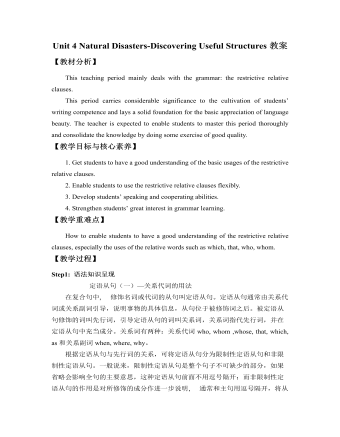
新人教版高中英语必修1Unit 4 Natural Disasters-Discovering Useful Structures教案
【教材分析】This teaching period mainly deals with the grammar: the restrictive relative clauses.This period carries considerable significance to the cultivation of students’ writing competence and lays a solid foundation for the basic appreciation of language beauty. The teacher is expected to enable students to master this period thoroughly and consolidate the knowledge by doing some exercise of good quality.【教学目标与核心素养】1. Get students to have a good understanding of the basic usages of the restrictive relative clauses.2. Enable students to use the restrictive relative clauses flexibly.3. Develop students’ speaking and cooperating abilities.4. Strengthen students’ great interest in grammar learning.【教学重难点】How to enable students to have a good understanding of the restrictive relative clauses, especially the uses of the relative words such as which, that, who, whom.【教学过程】Step1: 语法知识呈现定语从句(一)—关系代词的用法在复合句中, 修饰名词或代词的从句叫定语从句。定语从句通常由关系代词或关系副词引导,说明事物的具体信息,从句位于被修饰词之后。被定语从句修饰的词叫先行词,引导定语从句的词叫关系词,关系词指代先行词,并在定语从句中充当成分。关系词有两种:关系代词who, whom ,whose, that, which, as和关系副词when, where, why。

新人教版高中英语必修1Unit 4 Natural Disasters-Reading & Thinking教案
5. Read to get detailed information about Paragraph 5.Q1. What shows the revival of Tangshan?Q2. How can Tangshan revive itself and get up on its feet again?Q3. In times of disasters, how can we go through it?T: In times of disasters, we should unify, show the wisdom and stay positive.Step 4 Activity 4 Highlighting the theme and reflecting1. Make a summary of the text.2. Further understand the titleQ: After our learning, why do you think the earth didn’t sleep on that night?T: An earthquake happened. The people in the earthquake suffered a lot, and the people outside Tangshan were concerned about the people there a lot.3. Reflect through discussion on what can be learnt after reading.T: Disasters are powerful. Unpreparedness can be deadly. Life is weak, but if people work together to help each other, disasters can be defeated.There is no love from disaster, but we have love in the human heart.Step 5 Assignment How does the writer convey that the earthquake was deadly, and that people were helpless during the earthquake? Try to find some attractive and impressive expressions and note them down.
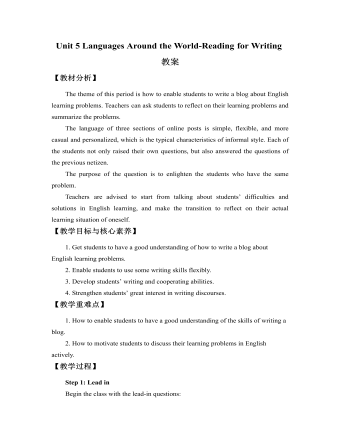
新人教版高中英语必修1Unit 5 Languages Around the World-Reading for Writing教案
Step 3: Read to sum upRead it again and sum up the problems of the three students, and then write down the advice that was given from others.Step 4: Work in pairs. List your learning problems in English and brainstorm some useful advice.Useful expressions ? I don't know how to…... Is a big difficulty for me. I cannot ...? You might try …. It's very important to…? I have no idea how/what .My biggest problem is .... ? I (also) have trouble with. My advice is …. This worked for me.? l cannot understand the teachers’ English in class.Step 5 Homework:为提高我校学生的英语口语水平,我们将举办英语演讲比赛(English- speaking contest),请你根据下面的信息,以学生会(the Students‘ Union)的名义写一份海报,欢迎全校同学参加,届时特邀本校美籍教师史密斯先生颁奖。? 报名时间 9月30日以前(报名:signup)? 报名地点 学生会办公室? 比赛时间 10月9日晚7:00~9:00? 比赛地点 学校大会议室? 奖励 前8名

新人教版高中英语必修2Unit 1 Cultural Heritage-Discovering Useful Structure教案二
This theme of the part is “ Describe people or things in greater detail”. Students have learned the grammar(restrictive relative clauses) in Book 1, and further review and consolidate its structure “prep+relative pronouns(which/whom)” and the relative adverbs(when, where and why), besides students should understand its form, meaning and functions. In this section, students should be able to express the grammar correctly in daily communication and in the writing. 1. Review the basic usages of relative pronouns and adverbs of attributive clauses . 2. Learn to use some special cases about restrictive relative clauses.3. Learn to write sentences with restrictive relative clauses flexibly according to the context.1. Review the basic usages of relative pronouns and adverbs of attributive clauses .2. Learn to use some special cases about restrictive relative clauses.3. Learn tow rite sentences with restrictive relative clauses flexibly according to the context.Step 1. Observe the following sentences, and mark the relative pronouns and the adverbs. 1. After listening to the scientists who had studied the problems, and citizens who lived near the dam, the government turned to the United Nations for help.2. Temples and other cultural sites were taken down piece by piece, and then moved and put back together again in a place where they were safe from the water.Step 2 PracticePlease complete these sentences with relative pronouns and relative adverbs and answer the following questions.Questions: 1. What is the head noun ?2. What relative words should be used ?3. What elements do they act in these sentences ?

新人教版高中英语必修2Unit 2 Wildlife Protection-Reading for Writing教案二
This lesson aims at making a poster about protecting wildlife after reading some posters. During reading students are guided to understand the content and try to summarize the posters with one sentence. Then students are guided to try to make a poster about protecting wildlife.1. Read the two posters and try to understand the summary sentences.2. Look at the two posters and try to understand what emotions they express.3. Try to summarize the features of posters4. Try to make a poster about wildlife.1. Look at the two posters and try to understand what emotions they express.2. Try to summarize the features of posters3. Try to make a poster about wildlife.Step 1 Lead inLook at the the posters on the textbook and ask:Which emotions do the posters communicate ?Step 2 Read the poster and answer the questions.1. What do you think of the animals in the poster on the left ?I think it is frightening and ugly.2. Why do we should protect the ugly animals ?All species--the good, the bad, and the ugly-- should be treated equally.The world needs all kinds--without variety, our planet cannot survive.3. Why are billions of trees being cut down every year ?To make paper for humans.4. What result will be lead to after the trees are cut down ?A lost of animal homes are being destroyed./The habitat of wildlife is being destroyed.Step 3 Find the feature of posters1. What does each poster use to stir up emotions ?On the left, it makes us a little frightened and it looks a little ugly, but it can activate our curiosity--What is it? And What is wrong with it?On the right, it makes us feel a little sad and want to protect them.

新人教版高中英语必修2Unit 3 The Internet-Reading and Thinking教案二
Q5:What's Jan's next goal?Her next goal is to start a charity website to raise money for children in poor countries.Q6:What can we learn from her experiences?We learn that when we go through tough times, we can find help and support from other people online. We learn that we can feel less lonelyStep 5: While reading---rethinkingQ1: What is Jan’s attitude to the Internet ?Thankful/Grateful, because it has changed her and her life.Q2: What writing skills is used in the article ?Examples(Jan’s example, the 59-year-old man’s and the 61-year-old woman’s example)Q3: Can you get the main idea of the article ?The Internet has changed Jan’s life/Jan’s life has been changed by the Internet.Step 6 Post reading---Retell the storyMuch has been written about the wonders of the World Wide Web. There are countless articles (1)telling(tell) us how the Internet has made our lives more convenient. But the Internet has done a lot (2)more(much) for people than simply make life more convenient. People’s lives (3) have been changed(change) by online communities and social networks so far. Take Jan for example, who developed a serious illness that made her (4)stuck(stick) at home with only her computer to keep (5)her(she) company. She joined an online group (6)where she could share problems, support and advice with others. She considered the ability to remove the distance between people as one of the greatest (7)benefits(benefit). She was so inspired (8)that she started an IT club in which many people have been helped. She has started to learn more about how to use the Internet to make society better. Her next goal is to start a charity website to raise money (9)for children in poor countries. Jan’s life has been (10)greatly(great) improved by the Internet.
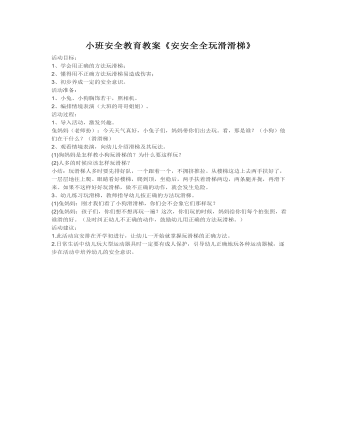
小班安全教育教案《安安全全玩滑滑梯》
2、懂得用不正确方法玩滑梯易造成伤害; 3、初步养成一定的安全意识。 活动准备: 1、小兔、小狗胸饰若干,照相机。 2、编排情境表演(大班的哥哥姐姐)。 活动过程: 1、导入活动,激发兴趣。 兔妈妈(老师扮):今天天气真好,小兔子们,妈妈带你们出去玩。看,那是谁?(小狗)他们在干什么?(滑滑梯) 2、观看情境表演,向幼儿介绍滑梯及其玩法。 (1)狗妈妈是怎样教小狗玩滑梯的?为什么要这样玩? (
![[幼儿园大班主题教案]我喜欢的成语](https://www.lfppt.com/PPT_IMG/2022-11/30/202211301643251f3d78643dc34b21a5da7b1b963f227e.png)
[幼儿园大班主题教案]我喜欢的成语
二、主题网络 丰富词汇 增长知识与才智 言简意赅 动物类谈话绘画制作表演 作 用 数字类 我喜欢的成语 成 语 种 类 同字类 表征活动 寓意相同类 我制作的成语邮票 凿壁借光 囊莹映雪 悬梁刺股 向他们学习三、关键经验1、知道汉语成语是中华民族瑰宝,能关注生活中使用的成语,激发喜爱成语的积极情感。2、了解汉语成语的种类、作用,体验其精炼明快、言简意赅的特点。3、愿意运用多种方式(讲、画、制作、表演)创造性地表现喜欢的成语。4、能运用调查、查阅、交流等方法进行探索学习。
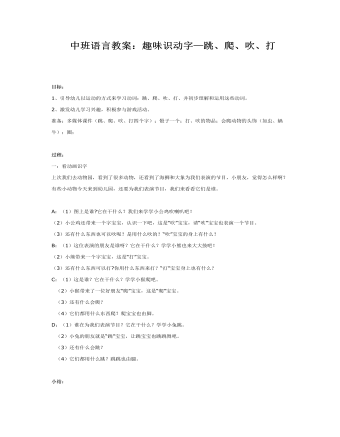
中班语言教案:趣味识动字—跳、爬、吹、打
2、激发幼儿学习兴趣,积极参与游戏活动。准备:多媒体课件(跳、爬、吹、打四个字);骰子一个;打、吹的物品;会爬动物的头饰(如虫、蜗牛);圈; 过程:一:看动画识字上次我们去动物园,看到了很多动物,还看到了海狮和大象为我们表演的节目,小朋友,觉得怎么样啊?有些小动物今天来到幼儿园,还要为我们表演节目,我们来看看它们是谁。 A:(1)图上是谁?它在干什么?我们来学学小公鸡吹喇叭吧!(2)小公鸡还带来一个字宝宝,认识一下吧,这是“吹”宝宝,请“吹”宝宝也表演一个节目。(3)还有什么东西也可以吹呢?是用什么吹的?“吹”宝宝的身上有什么?
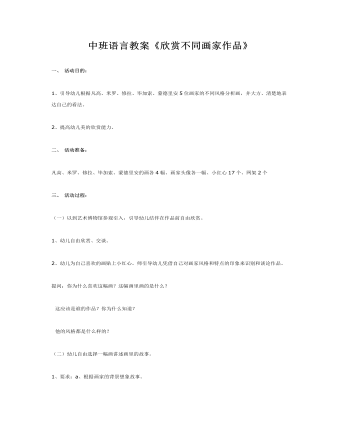
中班语言教案《欣赏不同画家作品》
2、提高幼儿美的欣赏能力。二、活动准备:凡高、米罗、修拉、毕加索、蒙德里安的画各4幅、画家头像各一幅、小红心17个、网架2个三、活动过程:(一)以到艺术博物馆参观引入,引导幼儿结伴在作品前自由欣赏。1、幼儿自由欣赏、交谈。2、幼儿为自己喜欢的画贴上小红心。师引导幼儿凭借自己对画家风格和特点的印象来
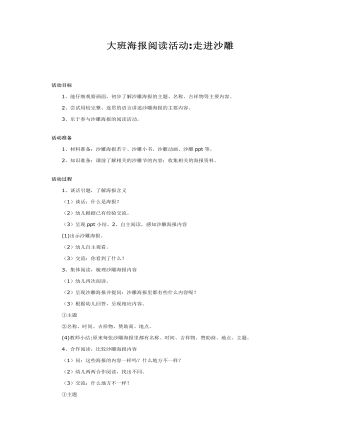
大班语言教案:大班海报阅读活动走进沙雕
2、尝试用较完整、连贯的语言讲述沙雕海报的主要内容。3、乐于参与沙雕海报的阅读活动。活动准备1、材料准备:沙雕海报若干、沙雕小书、沙雕动画、沙雕ppt等。2、知识准备:课前了解相关的沙雕节的内容;收集相关的海报资料。活动过程1、谈话引题,了解海报含义 (1)谈话:什么是海报? (2)幼儿根据已有经验交流。
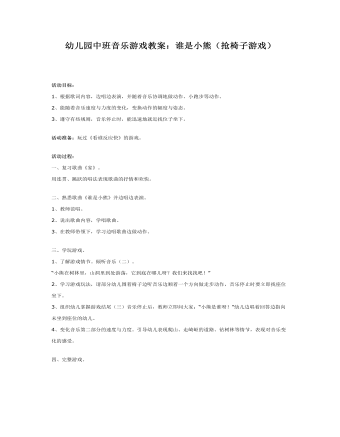
幼儿园中班音乐游戏教案:谁是小熊
活动准备:玩过《看谁反应快》的游戏。 活动过程: 一、复习歌曲《家》。 用连贯、跳跃的唱法表现歌曲的抒情和欢快。 二、熟悉歌曲《谁是小熊》并边唱边表演。 1、教师范唱。 2、说出歌曲内容,学唱歌曲。 3、在教师带领下,学习边唱歌曲边做动作。 三、学玩游戏。 1、了解游戏情节。倾听音乐(二)。 “小熊在树林里,山洞里到处游荡,它到底在哪儿呀?我们来找找吧!”
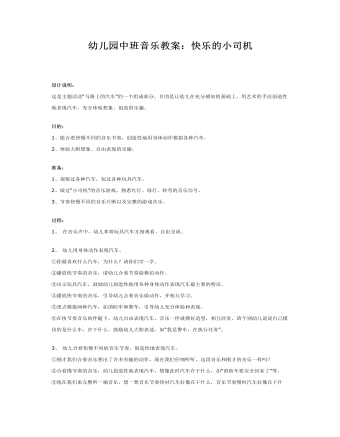
幼儿园中班音乐教案:快乐的小司机
目的: 1、能合着快慢不同的音乐节奏,创造性地用身体动作模拟各种汽车。 2、体验大胆想象、自由表现的乐趣。准备: 1、观察过各种汽车,玩过各种玩具汽车。 2、做过“小司机”的音乐游戏,熟悉红灯、绿灯、转弯的音乐信号。 3、节奏快慢不同的音乐片断以及完整的游戏音乐。过程:1、在音乐声中,幼儿拿着玩具汽车互相观看、自由交谈。2、幼儿用身体动作表现汽车。
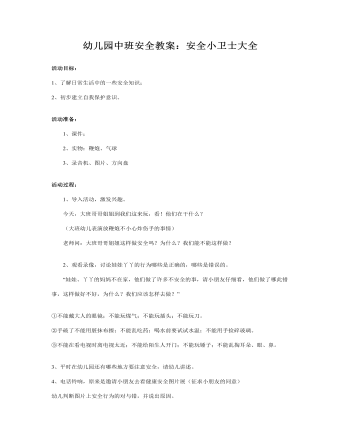
幼儿园中班安全教案:安全小卫士大全
活动准备:1、课件;2、实物:鞭炮、气球3、录音机、图片、方向盘活动过程:1、导入活动,激发兴趣。 今天,大班哥哥姐姐到我们这来玩,看!他们在干什么? (大班幼儿表演放鞭炮不小心炸伤手的事情) 老师问:大班哥哥姐姐这样做安全吗?为什么?我们能不能这样做?
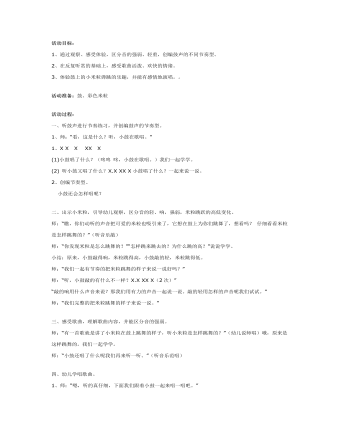
幼儿园大班音乐教案:跳舞的小米粒
活动准备:鼓、彩色米粒活动过程: 一、听鼓声进行节奏练习,并创编鼓声的节奏型。 1、师:“看,这是什么?听,小鼓在歌唱。” 1、X X X XX X (1)小鼓唱了什么?(咚咚咚,小鼓在歌唱。)我们一起学学。 (2) 听小鼓又唱了什么?X.X XX X小鼓唱了什么?一起来说一说。 2、创编节奏型。 小鼓还会怎样唱呢?二、出示小米粒,引导幼儿观察,区分音的轻、响,强弱,米粒跳跃的高低变化。 师:“瞧,你们动听的声音把可爱的米粒也吸引来了,它想在鼓上为你们跳舞了,想看吗?仔细看看米粒是怎样跳舞的?”(听音乐敲) 师:“你发现米粒是怎么跳舞的?”“怎样跳来跳去的?为什么跳的高?”说说学学。 小结:原来,小鼓敲得响,米粒跳得高,小鼓敲的轻,米粒跳得低。 师:“我们一起有节奏的把米粒跳舞的样子来说一说好吗?” 师:“听,小鼓敲的有什么不一样?X.X XX X(2次)” “敲的响用什么声音来说?那我们用有力的声音一起说一说。敲的轻用怎样的声音呢我们试试。” 师:“我们完整的把米粒跳舞的样子来说一说。”
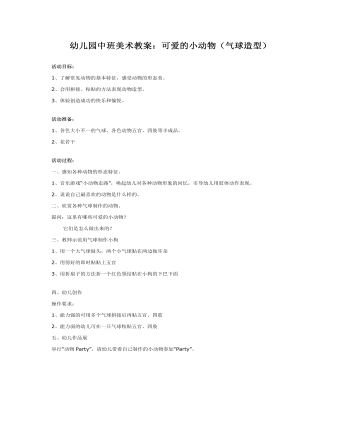
幼儿园中班美术教案:可爱的小动物
2、会用拼接、粘贴的方法表现动物造型。 3、体验创造成功的快乐和愉悦。活动准备:1、各色大小不一的气球,各色动物五官、四肢等半成品。 2、花若干活动过程: 一、感知各种动物的形态特征。 1、音乐游戏“小动物走路”,唤起幼儿对各种动物形象的回忆,引导幼儿用肢体动作表现。 2、说说自己最喜欢的动物是什么样的。 二、欣赏各种气球制作的动物。 提问:这里有哪些可爱的小动物?
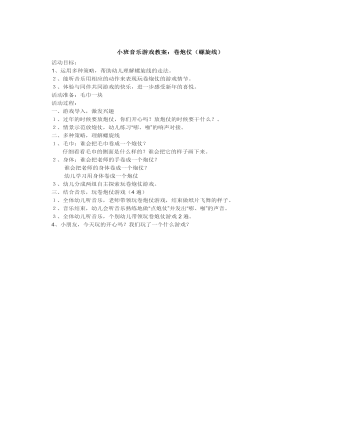
小班音乐游戏教案:卷炮仗(螺旋线)
2、能听音乐用相应的动作来表现玩卷炮仗的游戏情节。 3、体验与同伴共同游戏的快乐,进一步感受新年的喜悦。 活动准备:毛巾一块 活动过程: 一、游戏导入,激发兴趣 1、过年的时候要放炮仗,你们开心吗?放炮仗的时候要干什么?。 2、情景示范放炮仗,幼儿练习“嘭、啪”的响声对接。 二、多种策略,理解螺旋线 1、毛巾:谁会把毛巾卷成一个炮仗? 仔细看看毛巾的侧面是什么样的?谁会把它的样子画下来。
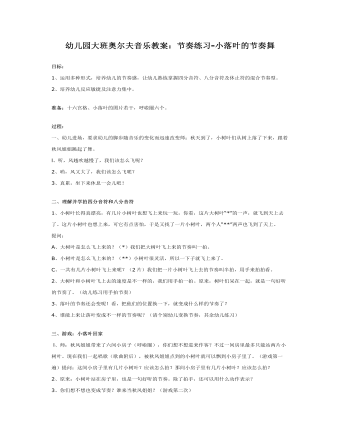
大班奥尔夫音乐教案:小落叶的节奏舞
2、培养幼儿反应敏捷及注意力集中。准备:十六宫格、小落叶的图片若干,呼啦圈六个。过程:一、幼儿进场,要求幼儿的脚步随音乐的变化而迅速改变师:秋天到了,小树叶们从树上落了下来,跟着秋风姐姐跳起了舞。 l、听,风越吹越慢了,我们该怎么飞呢? 2、哟,风又大了,我们该怎么飞呢? 3、真累,坐下来休息一会儿吧!二、理解并学拍四分音符和八分音符 1、小树叶长得真漂亮,有几片小树叶也想飞上来玩一玩,你看,这片大树叶“*”的一声,就飞到天上去了。这片小树叶也想上来,可它有点害怕,于是又找了一片小树叶,两个人“**”两声也飞到了天上。 提问: A、大树叶是怎么飞上来的?(*)我们把大树叶飞上来的节奏叫一拍。 B、小树叶是怎么飞上来的?(**)小树叶很灵活,所以一下子就飞上来了。 C、一共有几片小树叶飞上来呢?(2片)我们把一片小树叶飞上去的节奏叫半拍,用手来拍拍看。 2、大树叶和小树叶飞上去的速度是不一样的,我们用手拍一拍。原来,树叶们呆在一起,就是一句好听的节奏了。(幼儿练习用手拍节奏) 3、落叶的节奏还会变呢!看,把他们的位置换一下,就变成什么样的节奏了? 4、谁能上来让落叶变成不一样的节奏呢?(请个别幼儿变换节奏,其余幼儿练习)
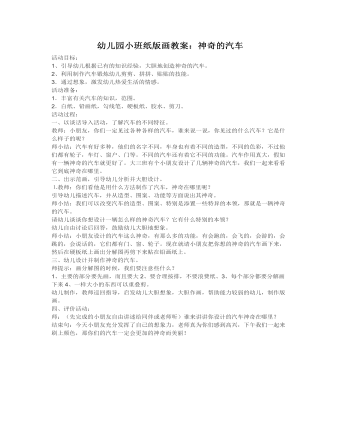
幼儿园小班纸版画教案:神奇的汽车
活动准备: 1.丰富有关汽车的知识,范图。 2.白纸、铅画纸,勾线笔、硬板纸、胶水、剪刀。 活动过程: 一、以谈话导入活动,了解汽车的不同特征。 教师:小朋友,你们一定见过各种各样的汽车,谁来说一说,你见过的什么汽车?它是什么样子的呢? 师小结:汽车有好多种,他们的名字不同,车身也有着不同的造型,不同的色彩,不过他们都有轮子,车灯、窗户、门等。不同的汽车还有着它不同的功能。汽车作用真大,假如有一辆神奇的汽车就更好了。大三班有个小朋友设计了几辆神奇的汽车,我们一起来看看它到底神奇在哪里。
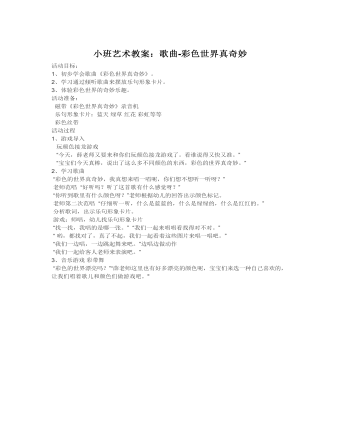
小班艺术教案:歌曲-彩色世界真奇妙
2、学习通过倾听歌曲来摆放乐句形象卡片。 3、体验彩色世界的奇妙乐趣。 活动准备: 磁带《彩色世界真奇妙》录音机 乐句形象卡片:蓝天 绿草 红花 彩虹等等 彩色丝带 活动过程 1、游戏导入 玩颜色接龙游戏 “今天,薛老师又要来和你们玩颜色接龙游戏了。看谁说得又快又准。” “宝宝们今天真棒,说出了这么多不同颜色的东西,彩色的世界真奇妙。”